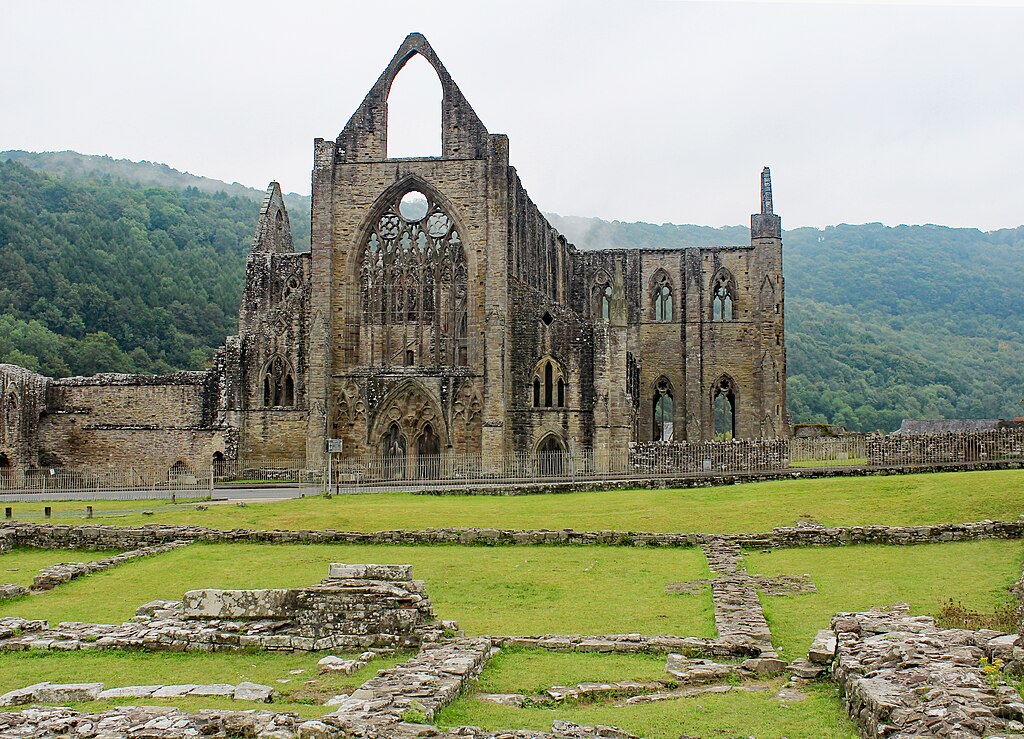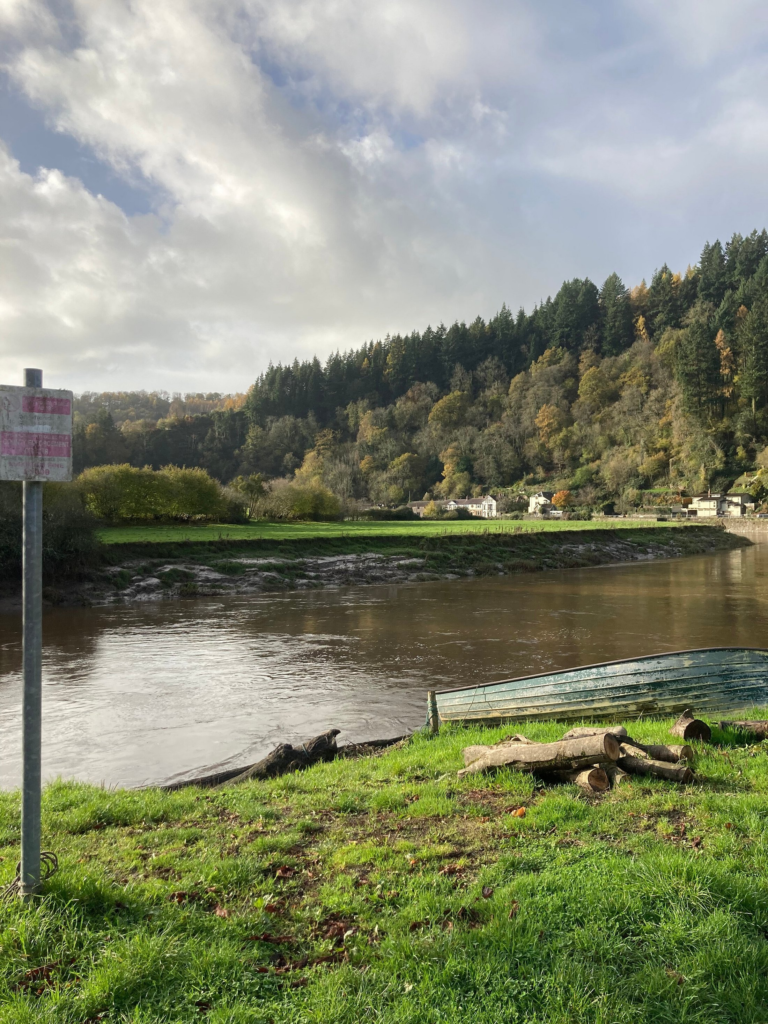TO CLIMB to the Eagle’s Nest—365 steps above the Wye Valley—you must be prepared.
Not just physically, but philosophically. It helps, for instance, to know that your exertions through steep, shaded woodlands will eventually be rewarded with confit duck leg or Welsh lamb rack, elegantly served at the region’s finest restaurant.
Welcome to walking, Wye Valley style.
 The view across the Wye Valley (Pic: Kevin Pilley)
The view across the Wye Valley (Pic: Kevin Pilley)Where you stay matters, and there’s no better base camp than Parva Farmhouse: a riverside gem near Tintern Abbey, just a scone’s throw from the teacakes of the Abbey Mill and close to the historic trails once trodden by Wordsworth, Thackeray, and even the donkeys who delivered coal and bread in the 18th century.
At Parva, the gourmet dinner menu is handed out the night before your walk—a clever move. Visions of lobster samosas and beef cheek in makhani sauce give even the most reluctant rambler a spring in their step. The following morning, a full English or poached eggs with Bovril crumpets provides fuel for the day. Each dish, like the view from Symonds Yat Rock, is its own Area of Outstanding Natural Beauty.
The grand tour
We were following in the footsteps of the Reverend William Gilpin, the 18th-century English cleric, artist and writer who arguably invented British tourism.
He pioneered the concept of the 'picturesque', celebrating natural scenery with a painter’s eye and influencing Romantic thought. He also advocated educational reform and parish improvement—a good egg all round.
In 1770, while headmaster at Cheam School, Gilpin sailed down the Wye and later published Observations on the River Wye (1782), the first British guidebook to view the countryside through the lens of this new-fangled “picturesque beauty.”
And, according to him, if you hadn’t navigated the Wye, “you have never seen the world.”
 Tintern Abbey (picture by Martinvi, image licensed under under the Creative Commons Attribution-Share Alike 4.0 International license)
Tintern Abbey (picture by Martinvi, image licensed under under the Creative Commons Attribution-Share Alike 4.0 International license)River romantics and cannon fire
IN THE late 1700s, the Wye Tour became a fashionable pursuit for the Georgian elite.
Tourists travelled by boat from Ross-on-Wye to Chepstow, pausing to watch the harvest moon rise through the east window of Tintern Abbey.
Wordsworth was among them. “No poem of mine,” he said of the valley, “was composed under circumstances more pleasant for me to remember.”
One such path leads from the boat-building cottages at Llandogo to Cleddon Shoots waterfall - a two-hour climb through the oaks and birch.
It’s not hard to imagine Wordsworth breathlessly composing new lines as he huffed uphill, with the ever-patient Mrs Wordsworth trailing behind, muttering about the difficulty of the "moderate ascent."
A gentler option is the six-mile “Picturesque Piercefield” walk from Chepstow Castle through landscaped parkland once owned by sugar magnate Valentine Morris.
Lookouts—then as now - are “judiciously placed among dense foliage.”
Coleridge praised the view as “the whole world imaged in its vast circumference.”
Gilpin himself recommended bringing a small quantity of gunpowder.
Hand it to Mr Morris’s gardener, he said, and have him fire a cannon as your boat drifted below the cliffs.
The echo, he promised, would be “wonderfully affecting”.
Above sits the Eagle’s Nest, the highest viewpoint on the Monmouthshire side of the Wye.
Built in 1828 for the Duke of Beaufort, it commands a sweeping panorama: both Severn Bridges, the Cotswold hills, and the meandering river below.
Nearby Wintour’s Leap—named after Sir John Wintour, who allegedly galloped his horse off the cliff to escape the Parliamentarians—is another showstopper.
Victorian and Georgian tourists would also picnic at Coldwell Rocks, take in the romantic ruins of Wilton Castle, and marvel at the iron foundries which, according to one 18th-century guide, “brought animation to the romantic scenes.”
At Ross-on-Wye, river cruises had already begun in the 1740s, thanks to Reverend John Egerton, rector and son of the Bishop of Hereford.
His boat tours eventually sparked a local industry of pleasure boats, launching from riverside inns like the Hope and Anchor or the Saracen’s Head at Symonds Yat—the world’s first river cruise terminals.
Today, you can still board the Kingfisher or Wye Pride for a one-hour cruise. At £10, it may be the best value historic voyage on the island.
 Parva Farmhouse from across the lake (Pic: Kevin Pilley)
Parva Farmhouse from across the lake (Pic: Kevin Pilley)The original filter
Gilpin’s passion for “charmingly grouped” scenery wasn’t just literary; it was technological. The Claude Glass—a tinted, convex mirror used to frame views—was the Georgian equivalent of a photo filter.
Tourists held them up to distort or "improve" the scene. If the lighting wasn’t right, a tinted glass could simulate dawn or dusk.
Gilpin wasn’t shy about altering nature: he once proposed knocking down parts of Tintern Abbey with a mallet to make it “more ruinous,” and thus, more picturesque.
He may also be the spiritual godfather of Instagram: “the picturesque,” he wrote, “is that kind of reality which is agreeable in a picture”.
The Wye Valley’s carboniferous limestone cliffs attract birds of prey—most famously the peregrine falcons that nest on Coldwell Rocks.
From April to August, you can watch them from the viewing platform at Symonds Yat Rock. Goshawks, sparrowhawks and buzzards also patrol the skies.
And on sun-dappled slopes like Coppett Hill, you might spot the rare pearl-bordered fritillary butterfly.
Historic inns and modern delights
TO WALK the Wye properly, you must promenade the Prospect in Ross-on-Wye and perhaps take a drink at the Royal Hotel, where 18th-century guests descended river-facing steps in elegant dress.
William Thackeray once praised the George Inn in Chepstow for its fresh salmon and friendly hosts—though sadly, it no longer lives up to its literary billing.
Happily, Parva Farmhouse exceeds expectations.
Run by Roger and Marta Brook (formerly of the Walnut Tree in Abergavenny), it offers seven en-suite rooms and gourmet dining from Wednesday to Saturday.
After a long hike, every plate looks like an oil painting and tastes even better.
The Regency fops and Victorian ramblers may have had bonnets and beaver hats, but they never had lobster samosa.
Whether you’re hiking to Whitestone in the footsteps of Wordsworth or cruising past the crumbling cliffs admired by Coleridge, the Wye has a way of combining effort with reward, poetry with plate.
The full Wye Valley Walk runs 136 miles from Chepstow to Plynlimon in Wales and celebrates its 50th anniversary this year.
But even a modest stroll brings you close to the Valley’s twin spirit guides: Gilpin the aestheticist, and Wordsworth the romantic.
Where to look/book:
- www.kingfishercruise.co.uk
- www.parvafarmhouse.co.uk / Tel: 01291 698411
- www.visitrossonwye.com
- www.visitherefordshire.co.uk
- www.celtictrailswalkingholidays.co.uk

